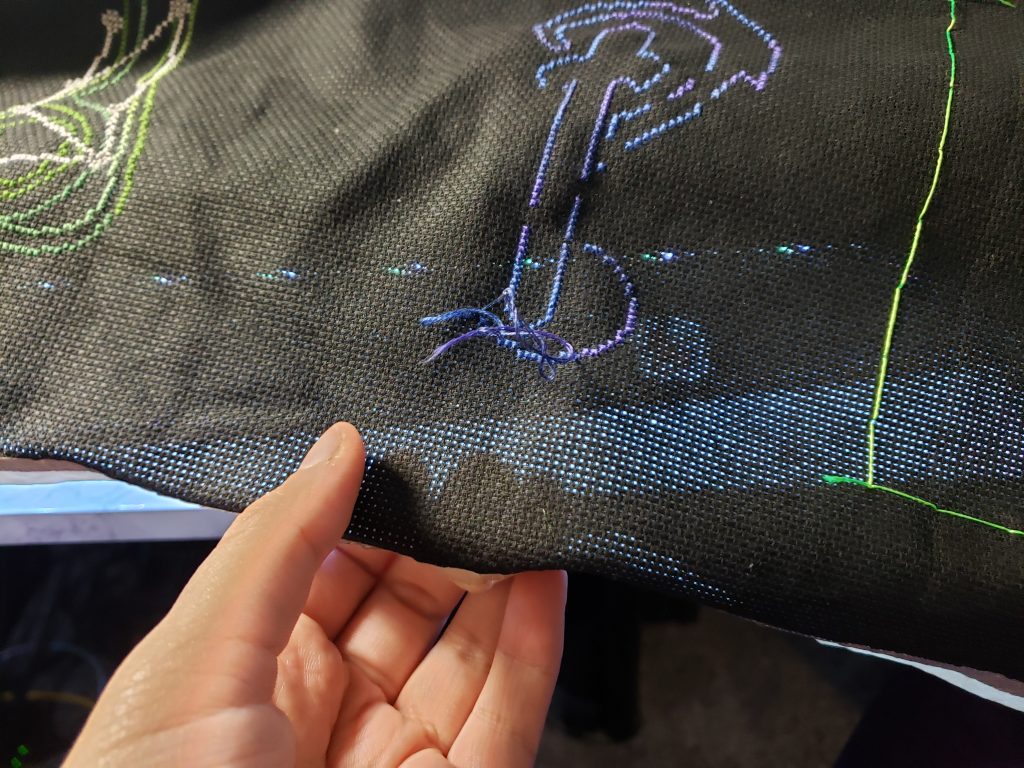Hello! If you’ve stumbled across this post it’s likely you’ve tried cross stitching on black or otherwise dark colored fabrics. It’s also likely you’ve struggled with it.
I’ve seen a lot of lovely designs that truly stand out best on black fabric. Vibrant colors just pop even more on dark backgrounds. You could do entire designs with just white thread on black fabric.
This post may contain affiliate links. If you buy something using one of these links, I earn a small commission. However, there is no extra cost to you. Thanks for understanding! Learn more in my Disclosures & Privacy Policy.
If you’re familiar with my Undertale Cross Stitch Book you’ll have seen quite a few patterns designed with black fabric in mind. But having done a fair amount of the test stitches pictured in the book, I can tell you it was a pain to work with. But also that it doesn’t have to be.
I also mentioned some of these tips in the book, but wanted to publish it online to hopefully help others in their stitching! So let’s get to it!
Table of Contents
Where to Buy Black Aida
Strangely, I’ve been asked this a lot. I thought it was fairly common, but I guess it’s not available everywhere. I’m only familiar with US shops, but here’s some links to where I’ve personally purchased black aida from.
If you’re not in the US – check my list of cross stitch supply resources and have a look around! There’s definitely options out there for you.
If this is your first time working on black – stick to 14 count aida until you’re comfortable. Increasing the count will only make these struggles worse!
Pick the Right Pattern
Pick a pattern designed for black or dark colored aidas. The last thing you want to have to do is stitch black on black. Trust me.
Even if the designer hasn’t stitched it on black, look for patterns with bright colors. 939 and 3371 are going to be just as bad as 310 would be.
Lighting
I don’t know about you guys, but I have the bad habit of working in low light. I’m nocturnal. I work third shift. Most overhead lights give me migraines. My stitching is often done by the light of my monitors.
Normally that’s sufficient. I have pretty decent low light vision. It can’t be good for my eyes, but it does work. Unless I’m working on black aida.
For darker fabrics lighting is crucial. Stitch in a well lit area. Preferably natural lighting if you’ve got a good window. But if you’re like me and are light sensitive, get a decent lamp.
I picked up a desk lamp to use at work, and loved it so much I ended up getting one for at home. The main feature that I was looking for was that it was dimmable – it has 7 brightness levels. I was pleased to see it had 5 color modes; though I always keep it at white so my thread colors don’t look off.
What I ended up loving so much though was its flexibility. It has a nice slim profile and can be bent and turned to be between you and your stitch. You can point it away from your face and entirely onto your project. It has truly been a game changer for me.
A ring light would also be good for this as you can look through the ring without the light in your face, while having you project evenly lit.
But this isn’t a lamp review, so let’s look at some other options.
White Backgrounds
The main struggle I’ve seen with stitching on dark fabrics is that it’s harder to see the holes. This is the case for most people.
The number one tip anyone will give you is to put something white underneath it. My craft desk is covered in white contact paper, so this helps a lot. However when I’m stitching on the couch, I’ll drape a white pillowcase or sheet of paper on my lap. If it’s a bit chilly, I have a white blanket I use for this. Get creative!

Take a look at how much difference that makes!
In fact, using light behind your project helps too! I tend to stitch at my computer desk with the Qsnap leaning lightly against the edge of my desk.
So I lined the edge my desk with LED lights! Check out how much easier that is to see while stitching! Plus, y’know RGB lighting is just cool.

Use a Hoop, Q-Snap, or Frame
I’m a firm believer that it’s okay to stitch in-hand sometimes. But this is not one of those times! Keeping the fabric taut is another way to help make those holes easy to see.
Not sure which one to pick? Check my blog post comparing them all.
Take Breaks
Yes, you heard me. Take breaks. Work on another design. Do something else for a bit.
I know, it already feels like you’re going much slower than normal. And you probably are. But it’s not gonna do your eyeballs any good by stubborning through it.
I usually have at least one other project on hand as a ‘palette cleanser’ if I’m doing something on black.
Get Creative
Okay this isn’t as much a tip on how to make stitching easier. But one thing I’ve found is I’m more likely to want to work on a project if it’s interesting. If it is fun.
So I recommend mixing things up. Try out some variegated thread. Use some glow in the dark kreinik. Add sparkles do your poject with metallic floss.

Yes, specialty threads come with their own set of annoyances. But look how gorgeous they can be!
What’s your favorite tip for working on black aida? Let me know on Twitter/Instagram!






